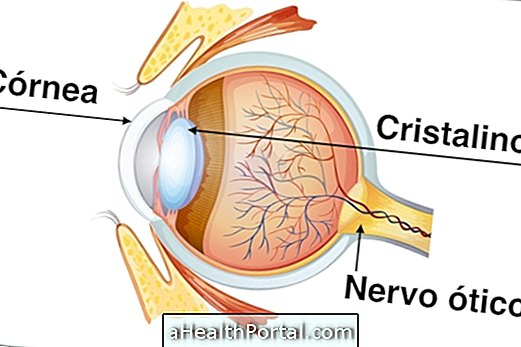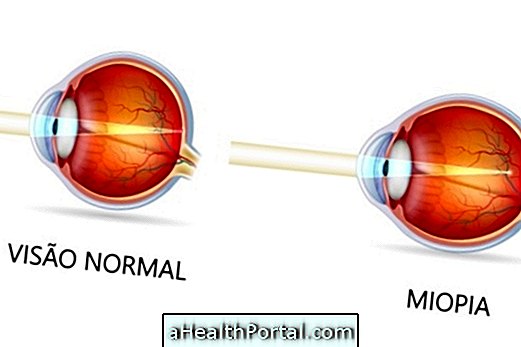Retinitis, also called retinosis, encompasses a set of diseases that affect the retina, an important region of the fundus of the eye that contains cells responsible for capturing images. It causes symptoms such as gradual loss of vision and the ability to distinguish colors, and may even lead to blindness.
The main cause is retinitis pigmentosa, degenerative disease that causes gradual loss of vision, most often caused by a genetic and hereditary disease. In addition, other possible causes of retinitis may include infections, such as cytomegalovirus, herpes, measles, syphilis or fungi, trauma to the eyes and the toxic action of some medicines such as Chloroquine or Chlorpromazine.
Although it has no cure, it is possible to treat this disease, which depends on its cause and the severity of the injury, and may involve protection against solar radiation and supplementation of vitamin A and omega 3.

How to identify
Pigmentary retinitis affects the function of photoreceptor cells, called cones and rods, that capture the images in color and in dark environments.
It can affect 1 or both eyes, and the main symptoms that may arise are:
- Blurred vision;
- Decreased or altered visual ability, especially in poorly lit environments;
- Night blindness;
- Loss of peripheral vision or altered visual field;
- Retinal detachment may occur;
- There may be inflammation of other parts of the eyes, especially if it is of infectious cause.
Loss of vision may gradually worsen, at a rate that varies according to its cause, and may even lead to blindness of the affected eye, also called amaurosis. In addition, retinitis can appear at any age, from birth to adulthood, which varies according to its cause.
How to confirm
The examination that detects the retinitis is the one of the bottom of the eye, made by the ophthalmologist, that detects some dark pigments in the eyes, in form of spider.
In addition, some tests that may aid in the diagnosis are vision, color and field of vision tests, eye exam and retinography, for example.
Main causes
Pigmentary retinitis is mainly caused by hereditary diseases transmitted from parents to offspring, and this genetic inheritance can arise in 3 ways:
- Autosomal dominant : in which it is enough only one of the parents to transmit to the child to be affected;
- Autosomal recessive : in which it is necessary that both parents transmit the gene so that the child is affected;
- Connected to the X chromosome : transmitted by maternal genes, with women carrying the affected gene, but transmitting the disease mainly, to the male offspring.
In addition, this disease can result in a syndrome, which in addition to affecting the eyes, can compromise other organs and functions of the body. Some examples include Usher's syndrome, Bardet-Biedl's syndrome, Leber's Congenital Amaurosis or Stargardt's Disease, for example.

Other types of retinitis
Retinitis can also be caused by some kind of inflammation in the retina, such as infections, medication use, and even strokes in the eyes. As vision impairment, in these cases, is stable and controllable with treatment, this condition is also called pigmentary pseudo-retinitis.
Some of the main causes are:
- Infection with the cytomegalovirus virus, or CMV, which infects the eyes of people with some impairment of immunity, such as those with AIDS, and is treated with antivirals such as Ganciclovir or Fodcarnet, for example;
- Other virus infections, such as in severe forms of herpes, measles, rubella and chickenpox, bacteria such as Treponema pallidum, which causes syphilis, parasites such as Toxoplasma gondii, which causes toxoplasmosis and fungi such as Candida.
- Use of toxic drugs, such as Chloroquine, Chlorpromazine, Tamoxifen, Thioridazine and Indomethacin, for example, which are remedies that generate the need for ophthalmologic follow-up during its use;
- Bumps in the eyes, by a trauma or an accident, that can compromise the function of the retina.
This type of retinitis is rarer than hereditary retinitis, and usually affects only one eye.
How is the treatment done?
There is no cure for retinitis, however, some ophthalmologist-based treatments may help control and prevent disease progression, such as vitamin A, beta-carotene, and omega-3 supplementation.
It is also important to provide protection against exposure to short wavelength light with the use of UV-A protective goggles and B-blockers to prevent acceleration of the disease.
Only in the case of infectious causes, it is possible to use medicines like antibiotics and antivirals, to cure the infection and to diminish the damage to the retina.
In addition, if vision loss has already occurred, the ophthalmologist can direct help such as magnifying glasses and computer tools, which can be useful to improve the quality of life of these people.






















/vacina-covid-19-como-funciona-eficcia-e-efeitos-colaterais.jpg)


